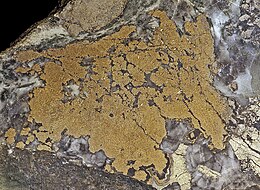Nickel arsenide
| Nickeline | |
|---|---|
 |
|
| General | |
| Category | Arsenide mineral |
|
Formula (repeating unit) |
nickel arsenide (NiAs) |
| Strunz classification | 2.CC.05 |
| Crystal system | Hexagonal |
| Crystal class | Dihexagonal dipyramidal (6/mmm) H-M symbol: (6/m 2/m 2/m) |
| Space group | P63/mmc |
| Unit cell | a = 3.602 Å, c = 5.009 Å; Z = 2 |
| Identification | |
| Color | Pale copper red with blackish tarnish. white with strong yellowish pink hue on polished section strongly anisotropic |
| Crystal habit | Massive columnar to reniform, rarely as distorted, horizontally striated, {1011} terminated crystals |
| Twinning | On {1011} producing fourlings |
| Cleavage | {1010} Imperfect, {0001} Imperfect |
| Fracture | Conchoidal |
| Tenacity | Brittle |
| Mohs scale hardness | 5 - 5.5 |
| Luster | metallic |
| Streak | brownish black |
| Specific gravity | 7.8 |
| Pleochroism | Strong (reflected light) |
| Fusibility | 2 |
| Other characteristics | garlic odor on heating |
| References | |
Nickeline or niccolite is a mineral consisting of nickel arsenide (NiAs) containing 43.9% nickel and 56.1% arsenic.
Small quantities of sulfur, iron and cobalt are usually present, and sometimes the arsenic is largely replaced by antimony. This last forms an isomorphous series with breithauptite (nickel antimonide).
When, in the medieval German Erzgebirge, or Ore Mountains, a red mineral resembling copper-ore was found, the miners looking for copper could extract none from it, as it contains none; worse yet, the ore also sickened them. They blamed a mischievous sprite of German mythology, Nickel (similar to Old Nick) for besetting the copper (German: Kupfer). This German equivalent of "copper-nickel" was used as early as 1694 (other old German synonyms are Rotnickelkies and Arsennickel).
In 1751, Baron Axel Fredrik Cronstedt was attempting to extract copper from kupfernickel mineral, and obtained instead a white metal that he called after the spirit, nickel. In modern German, Kupfernickel and Kupfer-Nickel designates the alloy Cupronickel.
The names subsequently given to the ore, nickeline from F. S. Beudant, 1832, and niccolite, from J. D. Dana, 1868, refer to the presence of nickel; in Latin, niccolum.
In 1971, the International Mineralogical Association recommended use of the name nickeline rather than niccolite.
The main compound within nickeline, nickel arsenide (NiAs), can be prepared by direct combination of the elements:
Ni(s) + As(s) → NiAs(s)
Nickeline is formed by hydrothermal modification of ultramafic rocks and associated ore deposits, and may be formed by replacement of nickel-copper bearing sulfides (replacing pentlandite, and in association with copper arsenic sulfides), or via metasomatism of sulfide-free ultramafic rocks, where metasomatic fluids introduce sulfur, carbonate, and arsenic. This typically results in mineral assemblaged including millerite, heazelwoodite and metamorphic pentlandite-pyrite via sulfidation and associated arsenopyrite-nickeline-breithauptite.
...
Wikipedia
